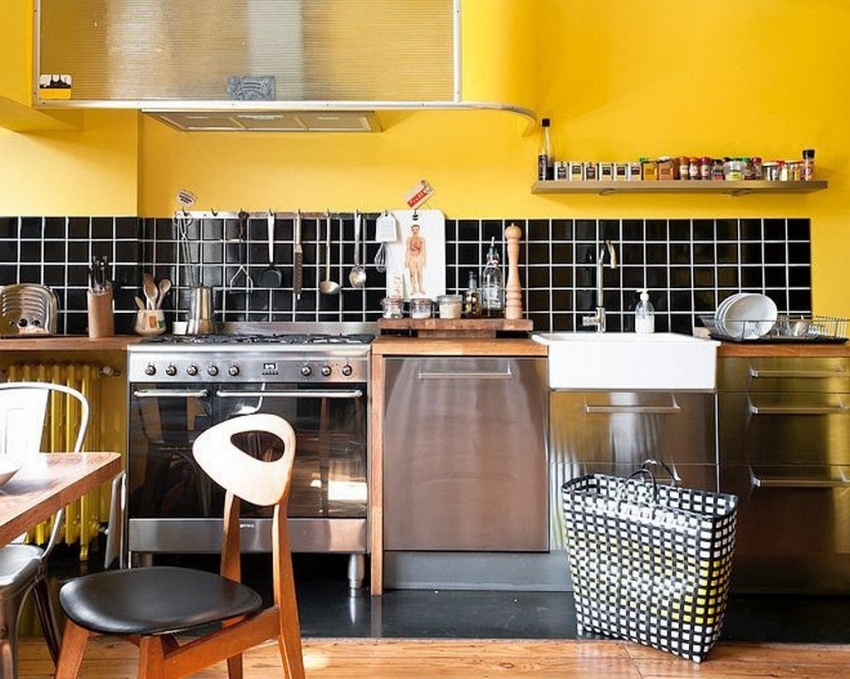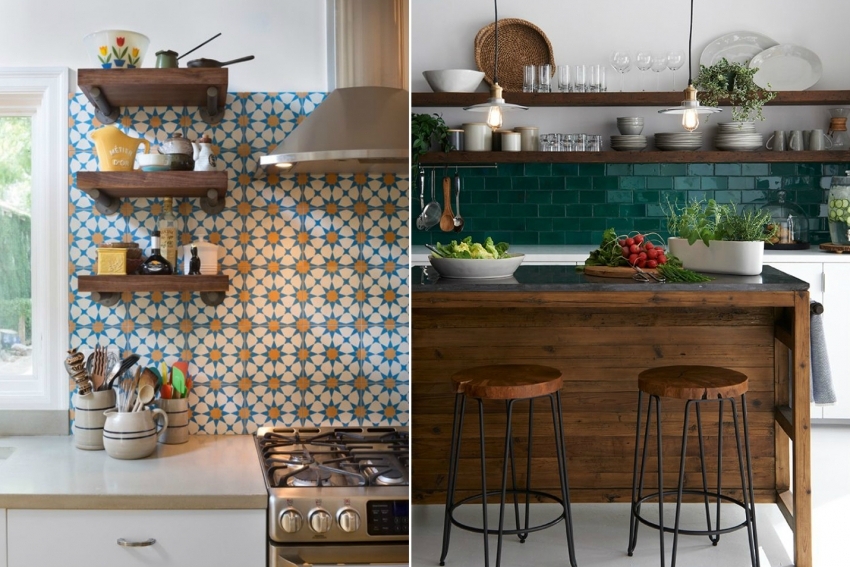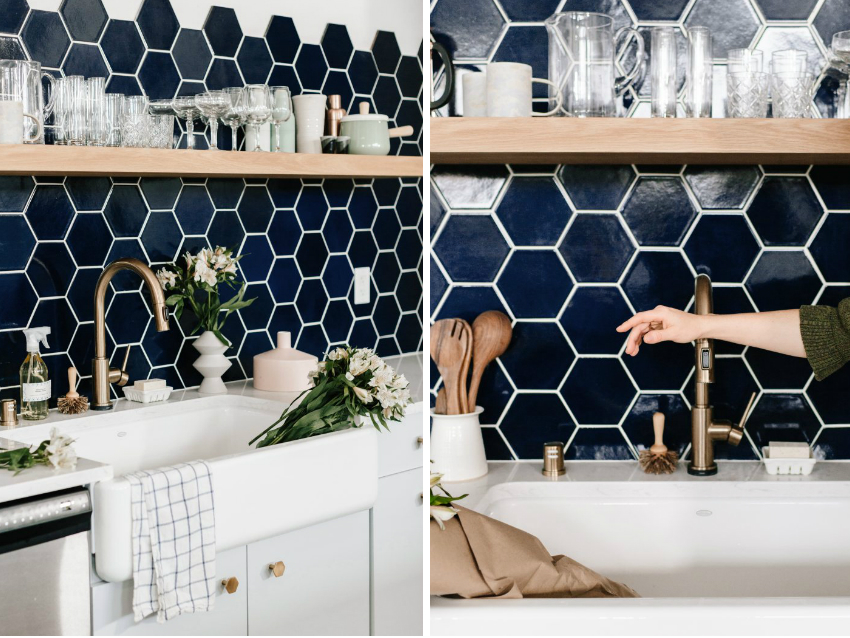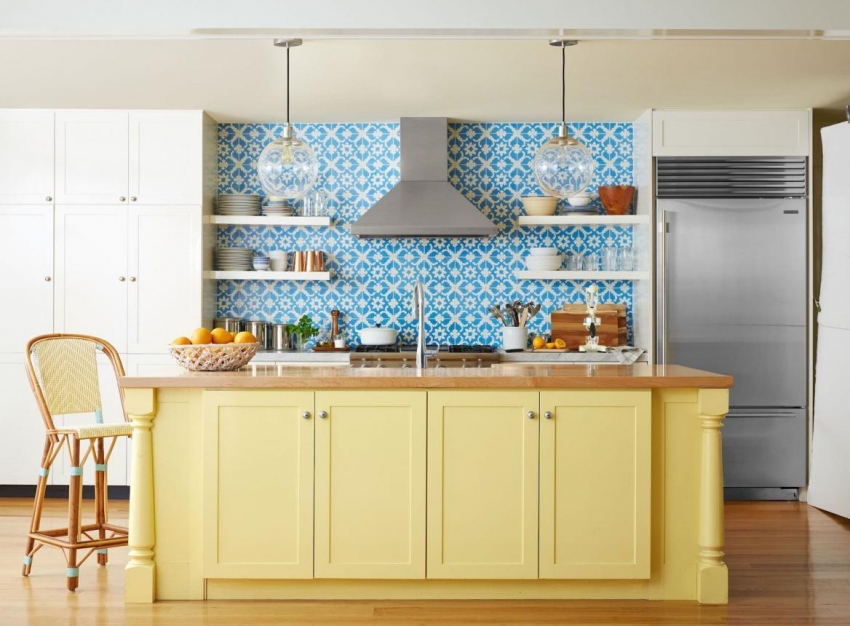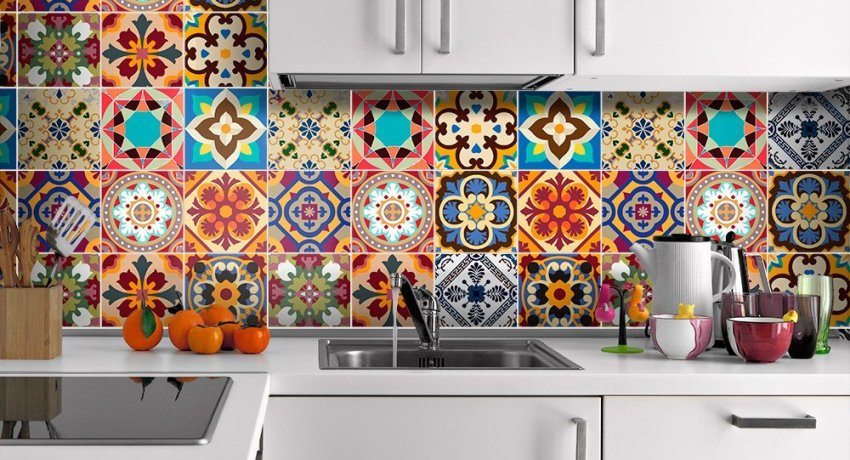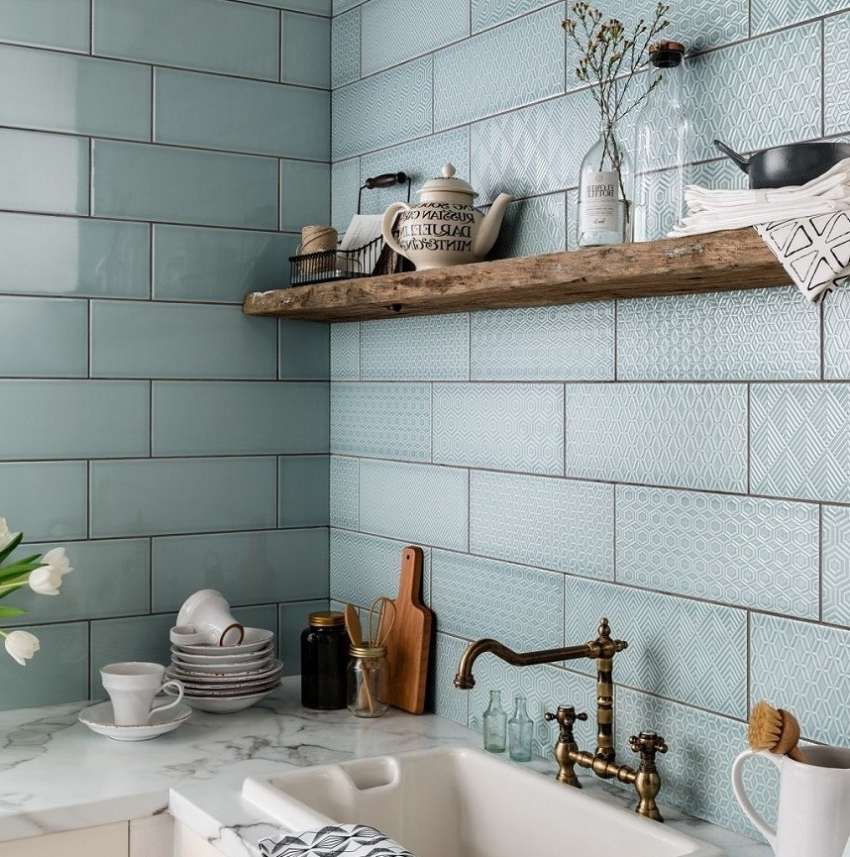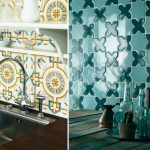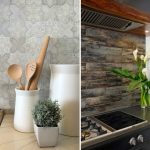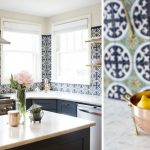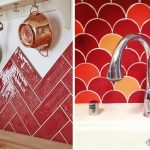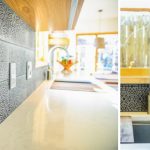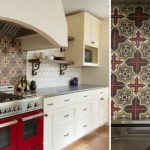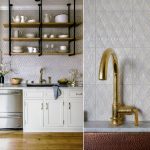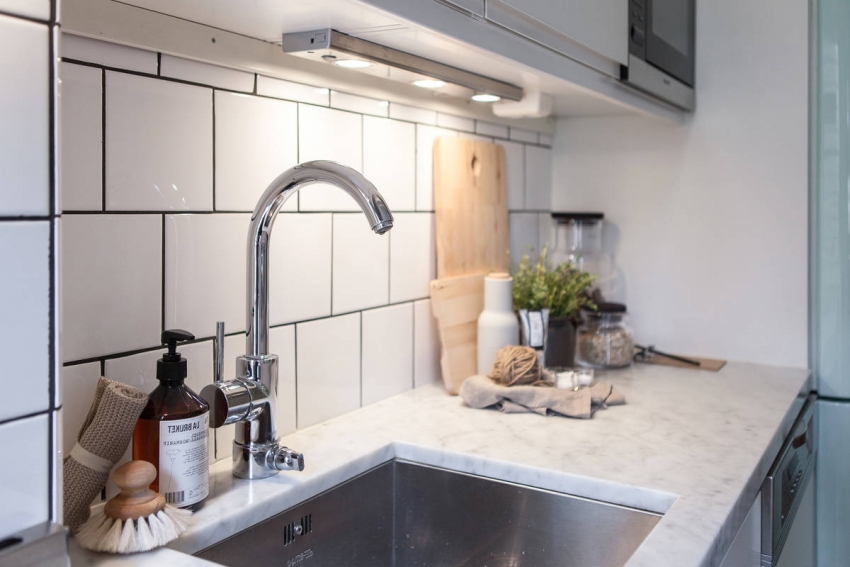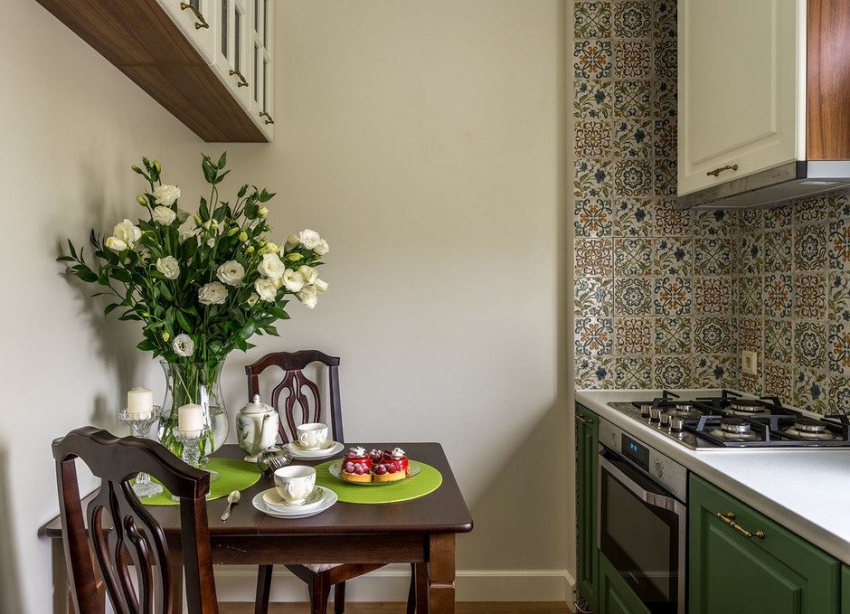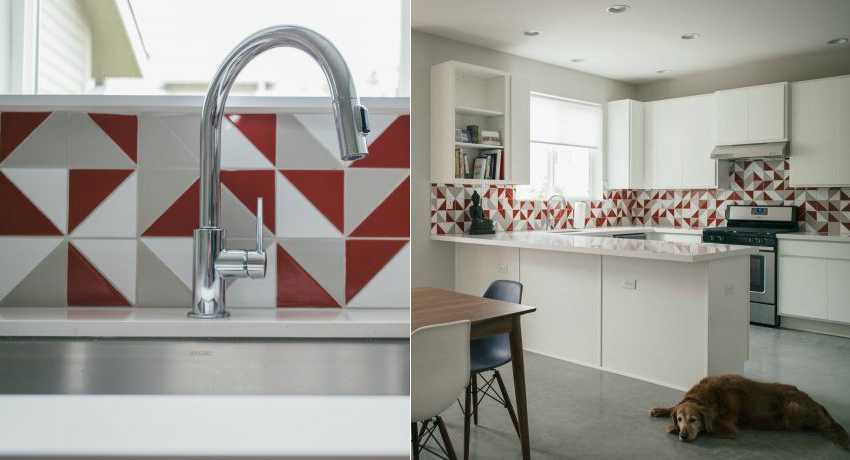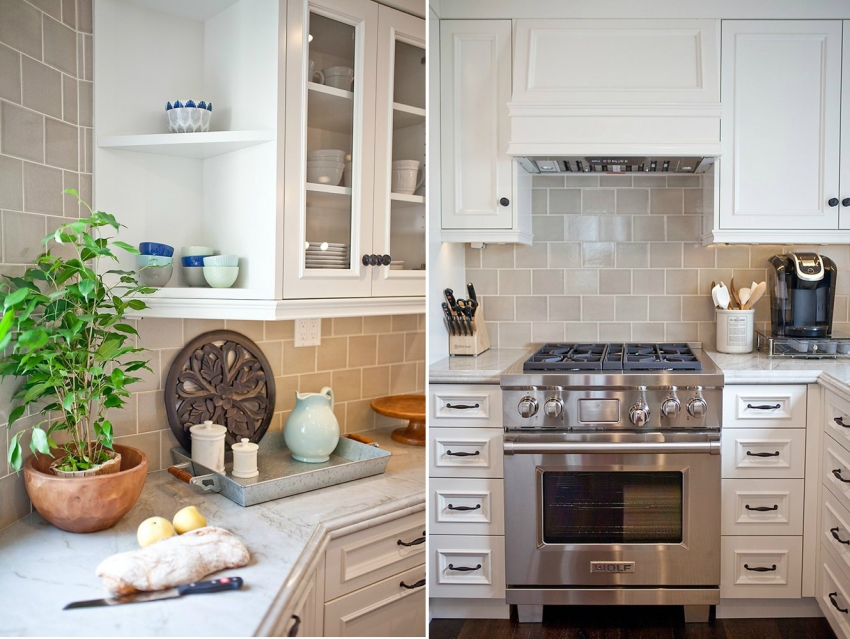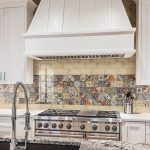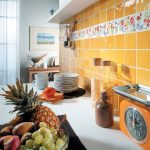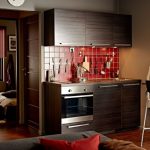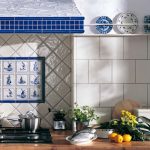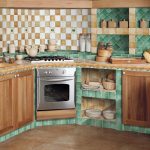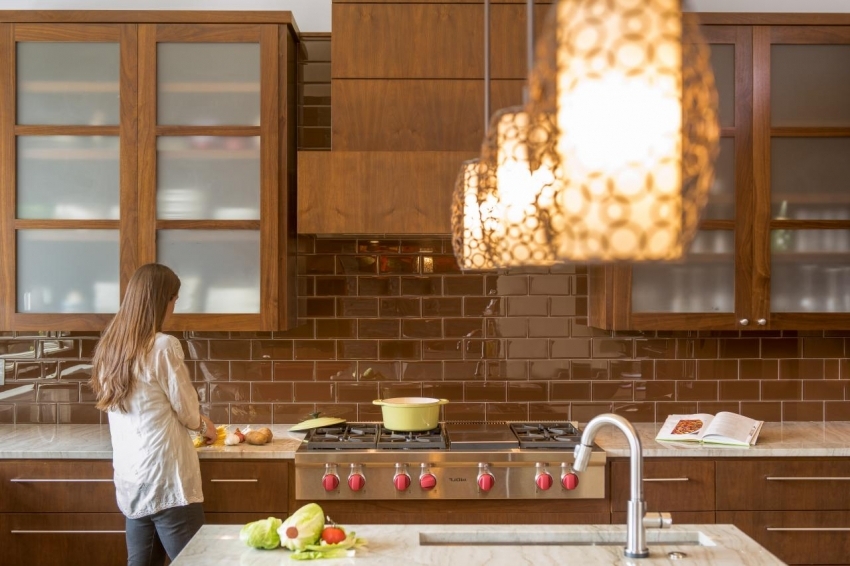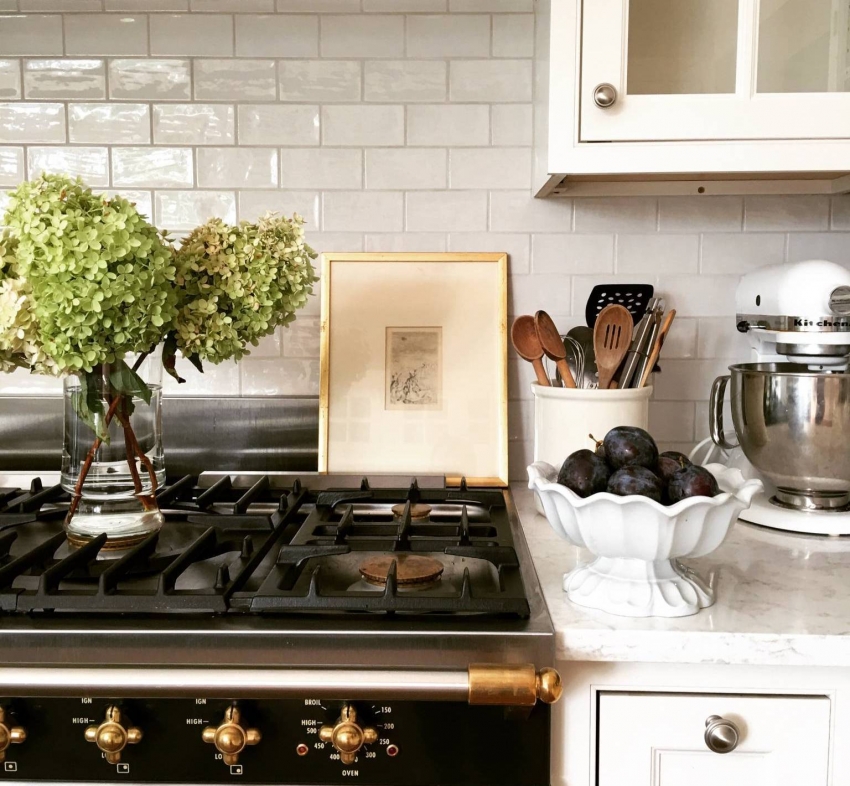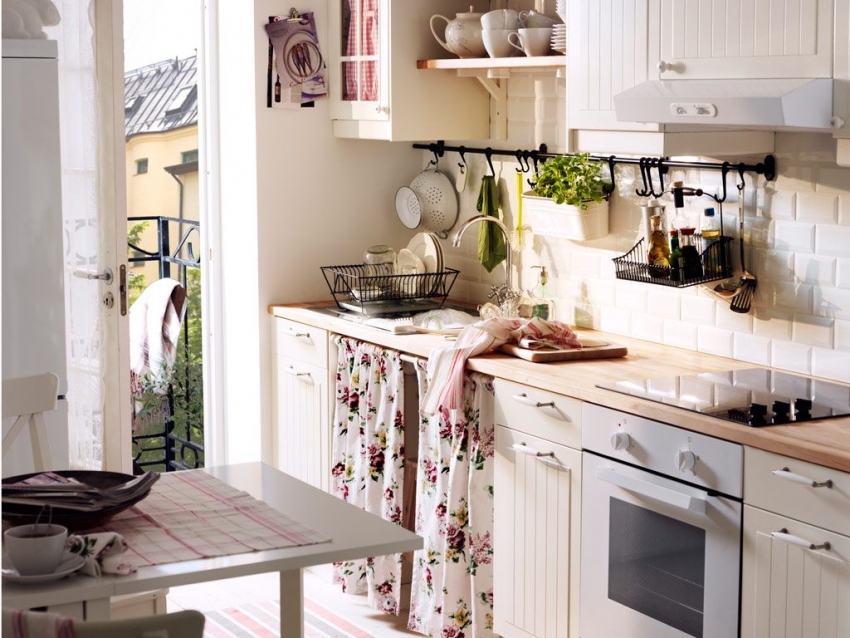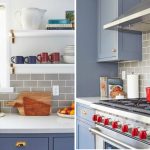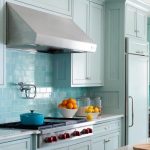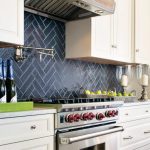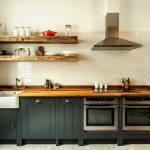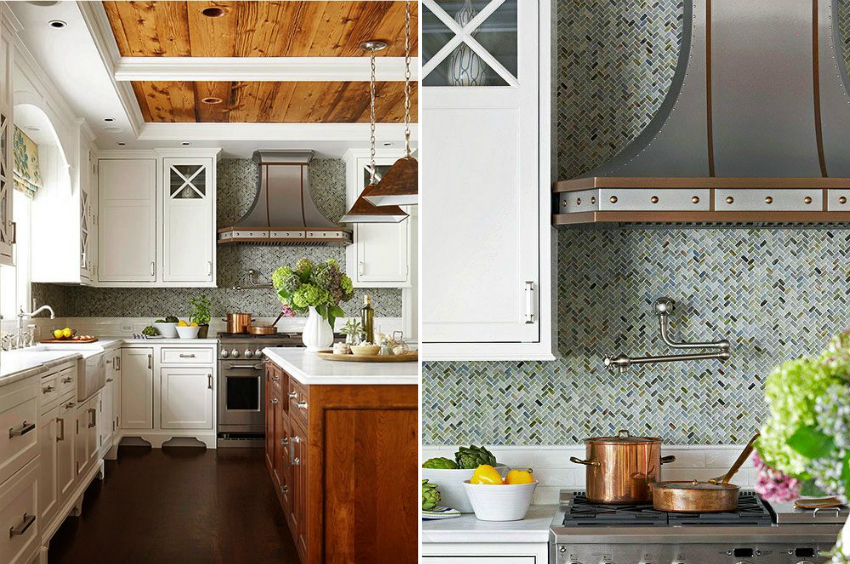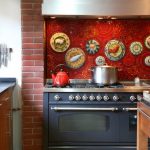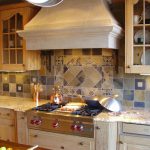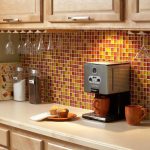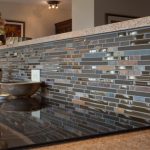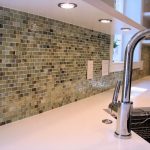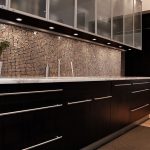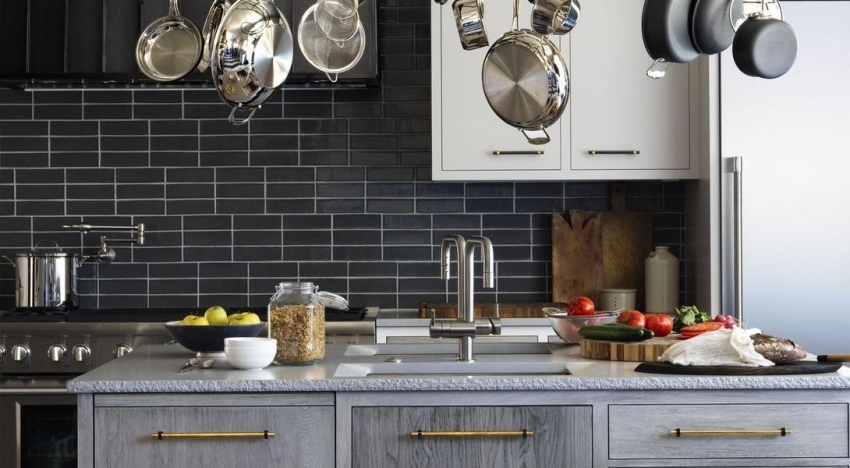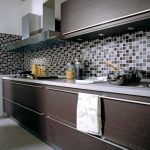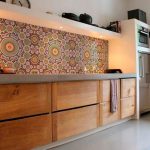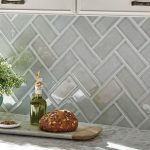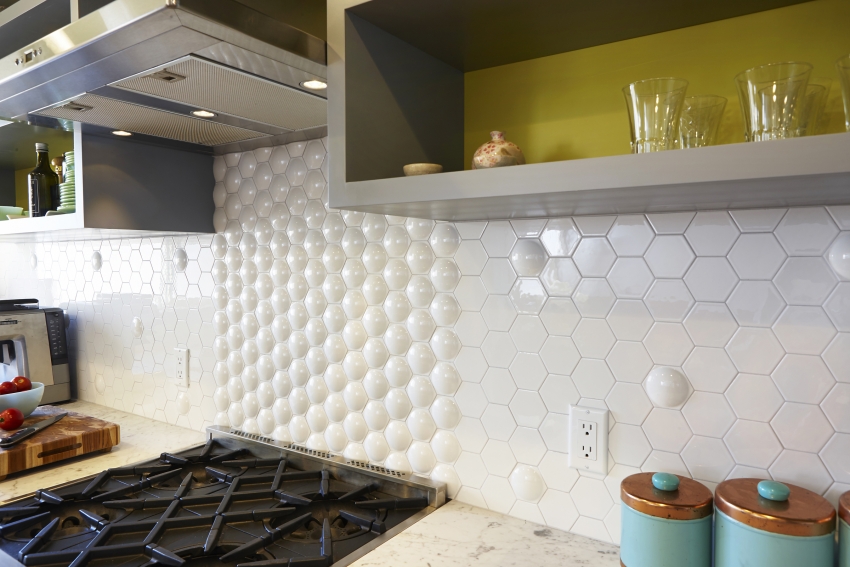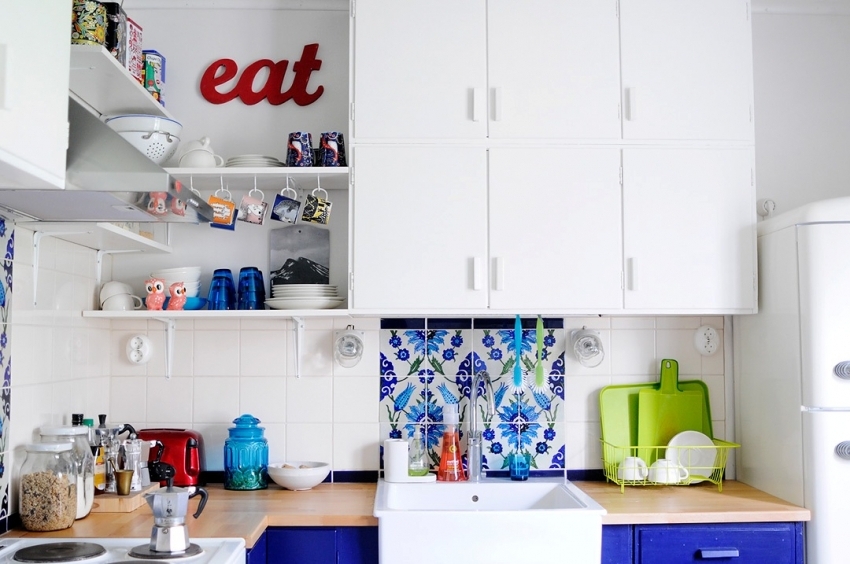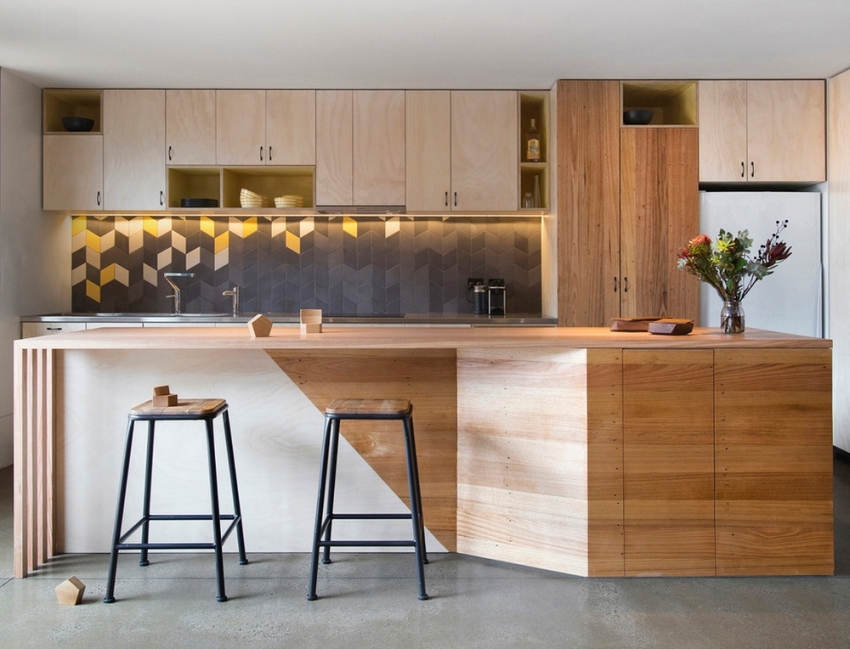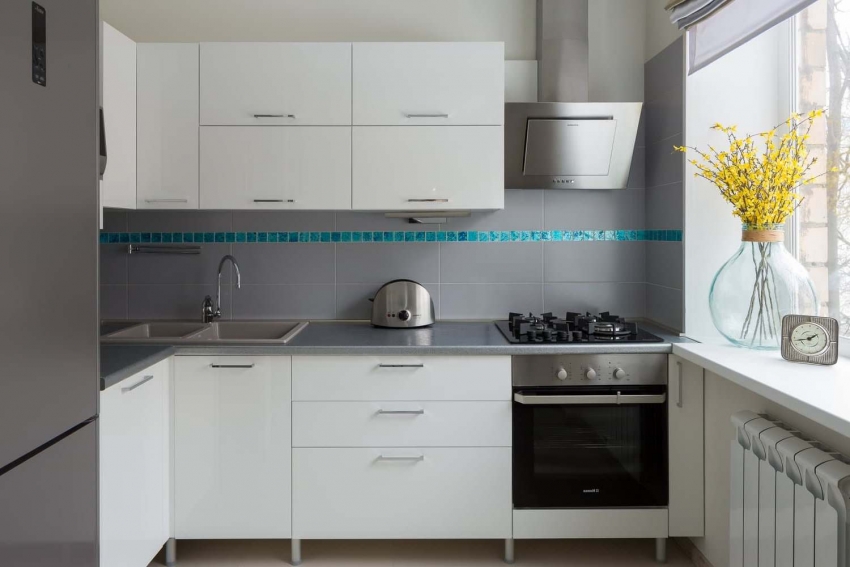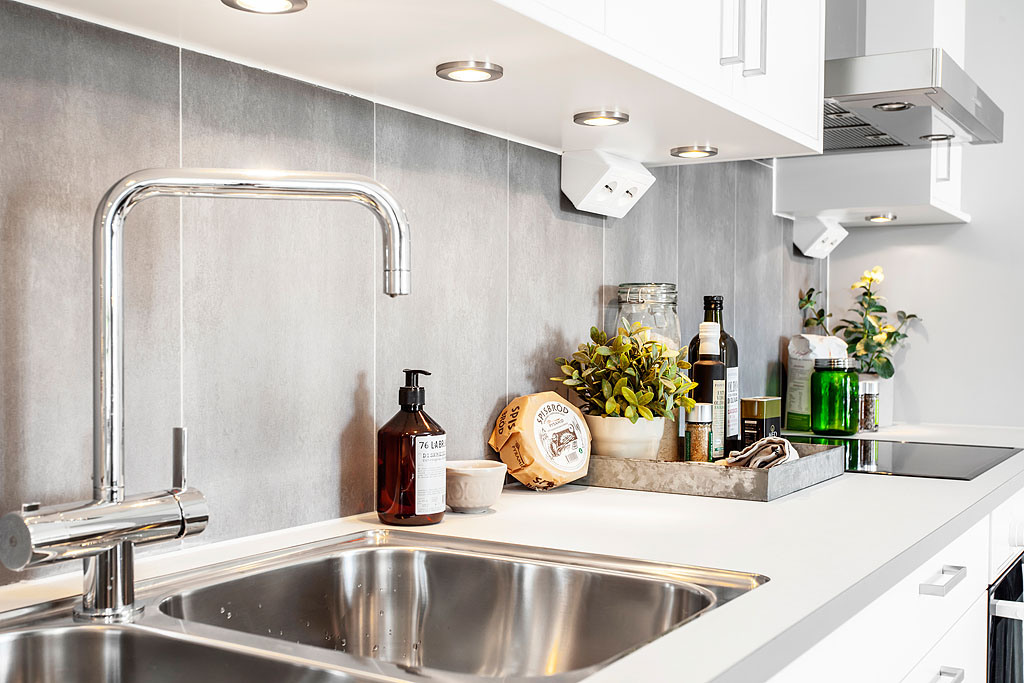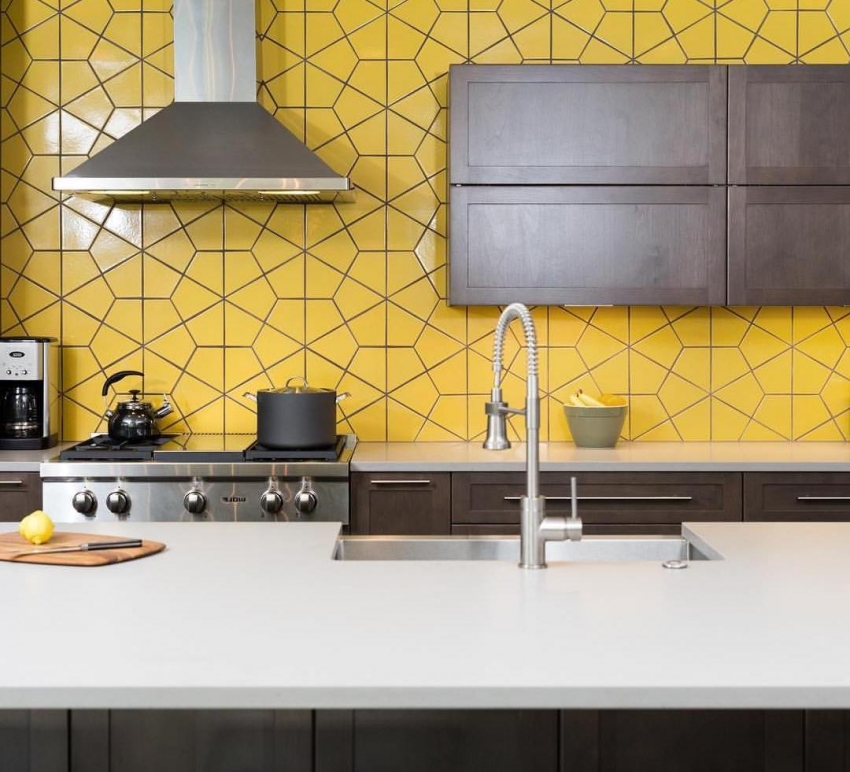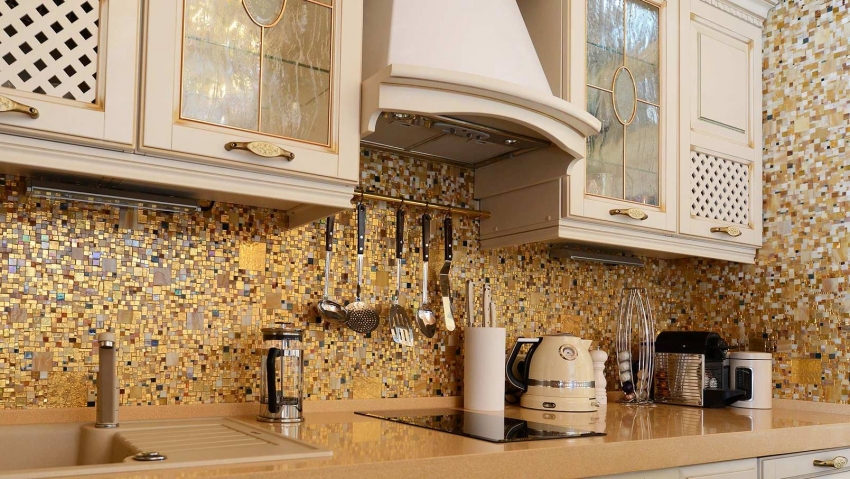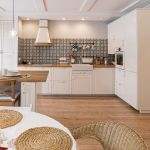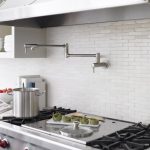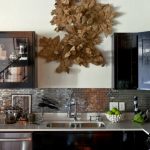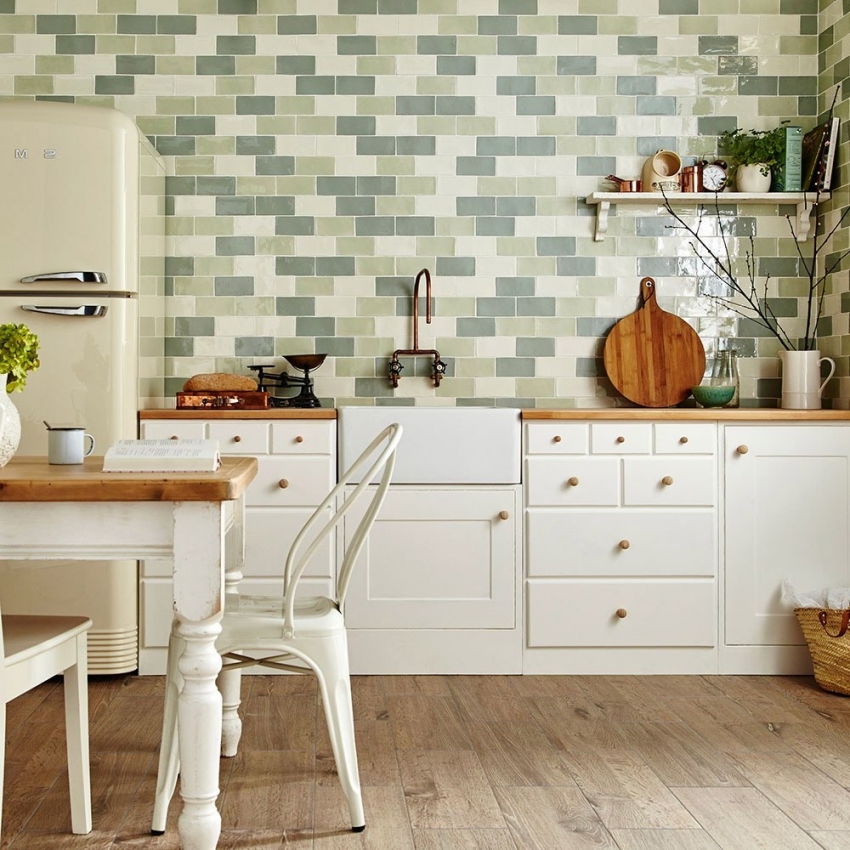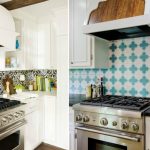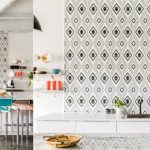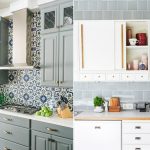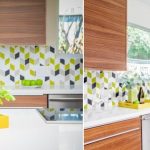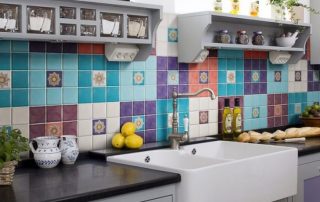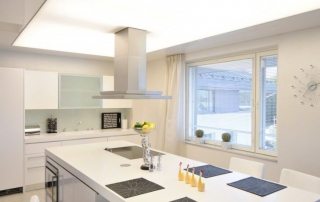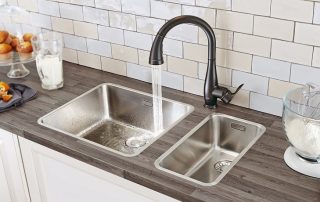Ceramic tile - one of the most popular materials for kitchen decoration. It is used as a floor and wall covering, as well as to create an apron over a work surface. Let's consider why it is worth making an apron for the kitchen from tiles, what are the criteria for choosing a material, what you should pay special attention to when buying, and how to choose a color scheme in accordance with the interior of the room.
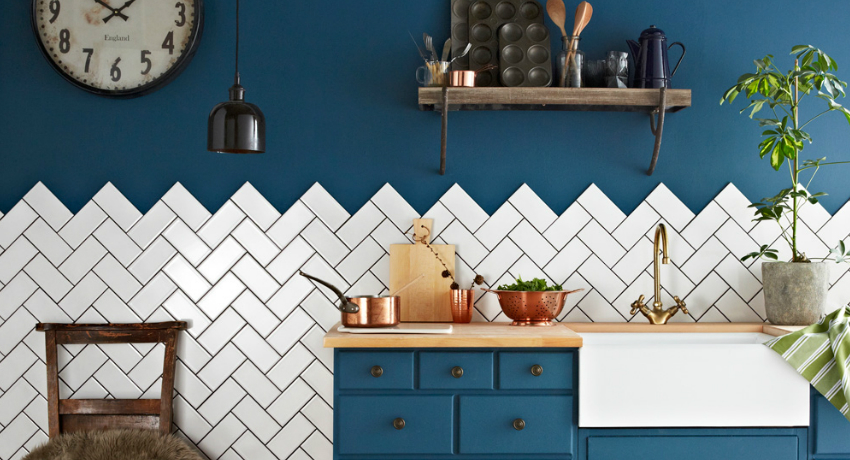
With the help of ceramic tiles, you can decorate your kitchen interior in an original and stylish way.
Content [Hide]
- 1 Tile kitchen apron: what material to use
- 2 What you should pay attention to before buying a tile for an apron in the kitchen
- 3 How much material do you need to buy for a tile apron in the kitchen
- 4 Tile kitchen apron: the most popular tile formats
- 5 How to diversify a plain tile apron in the kitchen: photo examples
- 6 Tile kitchen apron: design photo in various styles
- 7 The best manufacturers of tiles for the kitchen on the apron: catalog and description
Tile kitchen apron: what material to use
When choosing ceramic tiles for an apron for the kitchen, you should pay attention to some of the properties of this material. Here are some tips to help you choose the right tile for this purpose:
- it is best to use tiles with a glossy surface, as this makes it easier to clean, because it will be easier to remove dirt from such tiles. But you should know that all traces of water and grease are much more noticeable on the gloss, so you will have to clean it regularly. Another argument in favor of glossy apron tiles is the ability to reflect light, which allows you to visually expand the space. Naturally, a mirror apron for the kitchen will cope best with the task of expanding the space;
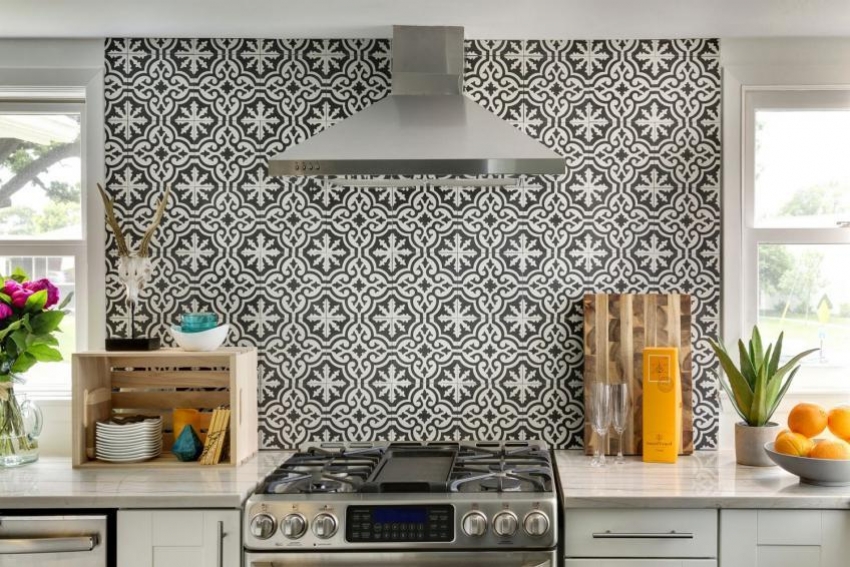
The use of monochrome shades of ceramic tiles for kitchen decoration requires bright accents and accessories in the interior.
- tiles with a smooth surface are preferable to embossed ones, since grease and dirt tend to cram into pores and crevices. It will be quite difficult to eliminate them in the future, so a smooth tile is always better;
- a universal option that will not spoil any interior - white tiles. To liven up the surface and add some variety to the design, you can add individual bright elements;
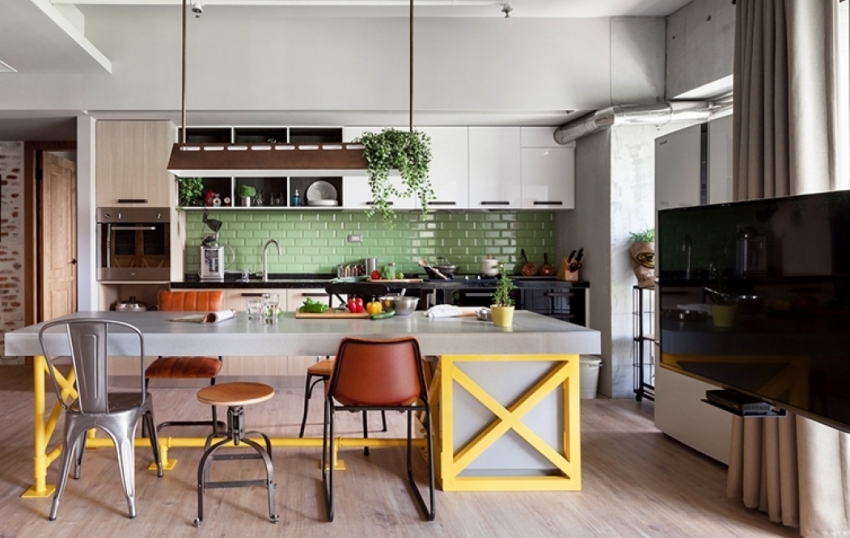
To decorate an apron over the work surface of a white kitchen, you can use ceramic tiles in a contrasting shade
- if we talk about maximum practicality and minimum maintenance requirements, then beige and brown tiles are the undisputed leader here. Ideally, these are ceramic tiles with a pattern in the form of streaks.This way small dirt will be the least visible.
The most difficult aspect of tiling an apron in the kitchen is the jointing of the tile joints, which are the most problematic areas of such a coating. The main problem is that over time, the light colored grout absorbs moisture and becomes dirty, darkening and losing its attractive appearance. Therefore, it is worth purchasing a special moisture-resistant and dirt-repellent composition that will prevent the appearance of fungus and will last long enough.
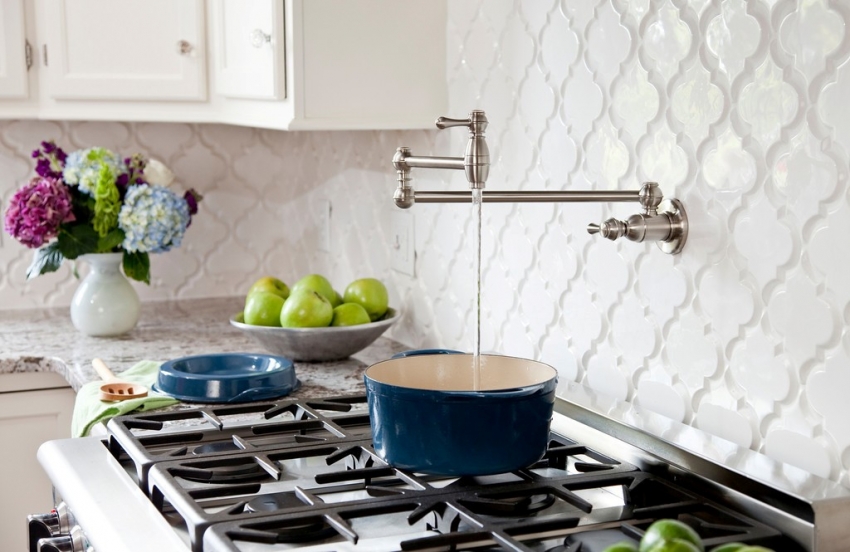
It is worth considering that textured tiles in the decoration of the apron require frequent cleaning.
Useful advice!The most practical and resistant to external factors is considered to be an epoxy grout. It is perfect for ceramic backsplash tiles in the kitchen.
Another great option to solve the problem of seams between tiles is to use rectified tiles, the edges of which are cut evenly. This allows the elements to be laid at a minimum distance from each other, making seams no more than 2 mm.
What you should pay attention to before buying a tile for an apron in the kitchen
When deciding on what to make an apron for the kitchen, the first thing to look for is the properties and characteristics of the material. Tile is not an exception, so we will consider several main aspects that are undoubtedly worthy of attention:
- the tiles must have a special protective coating that protects them from the effects of aggressive chemicals that will be used in the kitchen cleaning process. To make sure of the reliability of the selected material, you should pay attention to the marking, giving preference to the degree of protection A or AA;
- the same ceramic tile may differ in tone. This is normal as the elements are fired in different batches. But in order for the tiles on the apron to not differ in color, it is worth checking the contents of each package before buying;
- in different packages, tiles may differ not only in color, but also in size. There is even such a thing as caliber, which indicates how much the actual size of the elements differs from the declared one. So, for example, if the actual and declared size of the tile is 100x100 mm, then they say that the caliber is 0. In order for the apron to look beautiful, it is desirable that the caliber does not exceed 1;

Using mirror tiles for an apron allows you to visually expand the space of the kitchen
- before buying, you need to check the quality of the glaze. You can do this right in the store by examining random items for cracks, chips and scuffs. The tile surface should be as flat and smooth as possible.
Useful advice!If you purchased a tile for a kitchen backsplash, but do not start laying immediately, you need to store the material in a dry room, in no case allowing the back of the tile to come into contact with water. Otherwise, the tiles may crack after some time after installation.
How much material do you need to buy for a tile apron in the kitchen
Buying tiles, like any other material, is not worth it. Usually, experts recommend leaving a margin of about 5-10% if the laying method is traditional. In the case of diagonal placement of tiles or a combination of elements in a complex pattern, the recommended margin should be about 15%.
An important role in this issue is played by how many elements will be defective. It depends on the manufacturer: the more expensive and better the tiles are, the lower the percentage of defects in the batch is allowed.But for an inexpensive domestic product, 5% of defective products is not the limit.
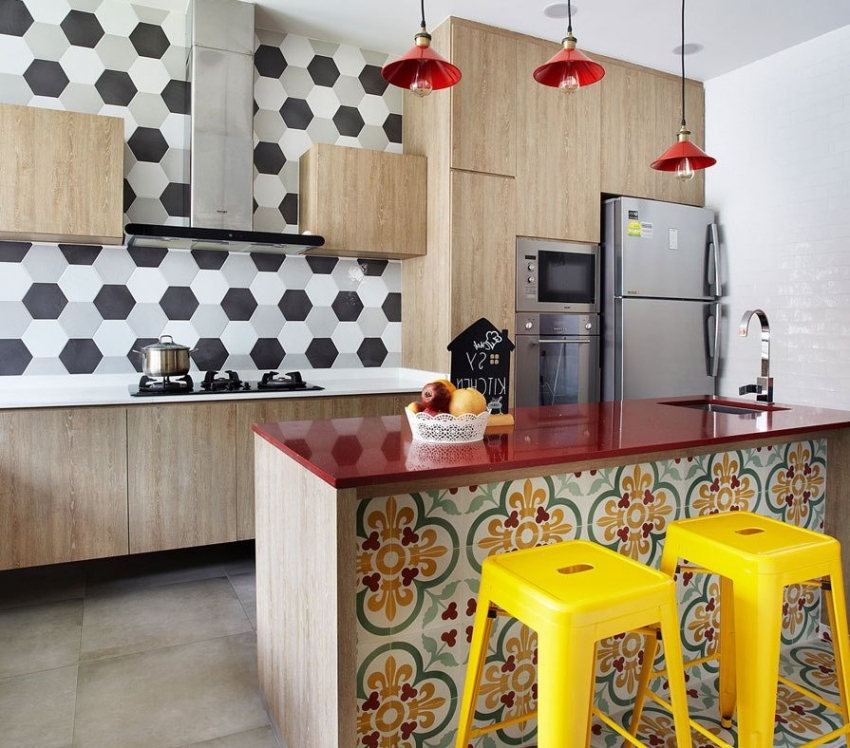
Ceramic tiles of different colors can be combined with each other, creating an interesting ornament on the apron
Useful advice!It is worth leaving a few whole tiles for the future, in case you need to replace a single damaged element. Finding the right option after a few years can be problematic, so you should take care of this in advance.
Related article:
Kitchen apron tile. Photo tiles of different types and styles
How to choose the right tile for an apron in the kitchen. Photos of tiles in catalogs of online stores, types of tiles for the apron. Apron design in the interior of the kitchen.
Tile kitchen apron: the most popular tile formats
Choosing the right tile size is another task that needs attention. It is best to give preference to such elements, the height and width of which is a multiple of the height and width of the surface on which the apron will be. This will minimize the need for pruning. As a rule, the size of the apron in the kitchen is not too large, and its height does not exceed 50-60 cm.
It is recommended that the tiles go 2-3 cm behind the upper and lower cabinets, and in the area of the hood the apron is higher. This should be taken into account when calculating the required amount of material.
Photo of aprons in the kitchen from 10x10 tiles
10x10 is the most popular tile size for wall aprons. In most cases, such elements allow you to do without pruning and can be installed as quickly and easily as possible. Compared to large tiles, such a small tile is much less of a hassle.
Such a small tile looks great in a small kitchen, visually expanding rather than cluttering the space. In addition, if the kitchen unit is small, then such a tile will look as organic and natural as possible.
Another advantage of this solution is the simplicity of cladding in hard-to-reach places. In addition, such small elements can be perfectly combined with other finishing materials. True, there are some difficulties, for example, in order to properly lay such a tile, certain experience and skills will be required, since there will be much more joints than in the case of laying tiles of a standard size.
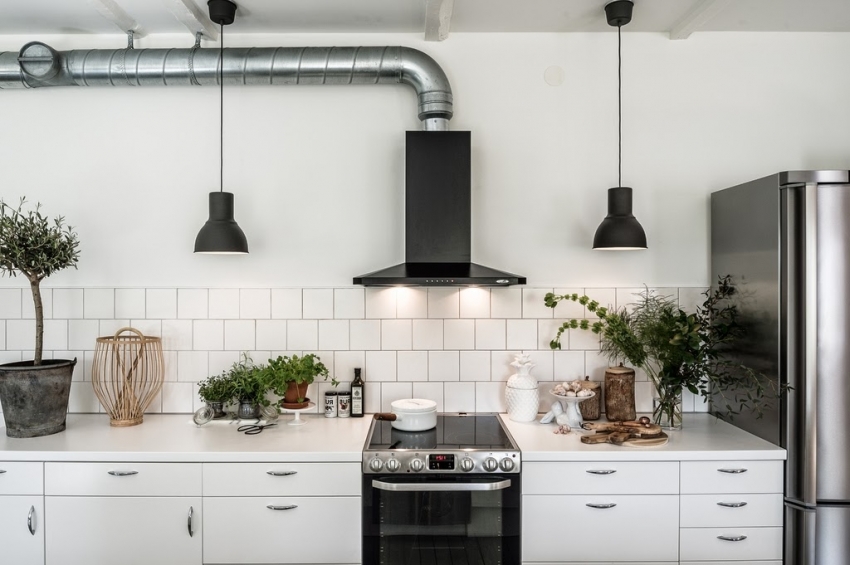
Square white tiles are often used for apron decoration Scandinavian style kitchens
As for the appearance of such tiles, you can find a wide variety of options on sale, although tiles with the image of flowers, fruits and still lifes are especially popular. As examples, you can consider a photo of aprons for a kitchen made of ceramic tiles of this size.
Useful advice! To facilitate the installation procedure, you can use a 10x10 tile imitation. In this case, the elements have a larger size, for example, 20x20, 20x30, 30x30, etc. But due to the additional depressions on the surface that separate the tiles, such a tile looks like a small one, and at the same time it fits easily and quickly.
Another important point to know before buying tiles, especially if you plan to combine several types видов the actual size of the tiles may differ from different manufacturers. For a small tile, the difference may be only a few millimeters, but large elements may differ by 1-2 cm. Therefore, so that the picture does not "float", you need to know the exact parameters in advance.
Brick tile for a kitchen apron: hog tile
The hog tile is very popular lately. It is often used for wall cladding as well as kitchen aprons. It looks like a rectangle, and the chamfers on its edges are beveled, which makes it look like a brick. This method of decoration looks organically in both modern and classic interiors, visually expanding the space.
On sale you can find a wide variety of shapes and colors of such tiles, not to mention a wide range of sizes. The standard parameters are considered to be 7.5x15 cm, however, 10x20 can also be found very often. In online stores you can find many other options, for example, 6.5x12, 15x45 cm and others.
Usually a hog is called a plain tile, the surface of which is smooth and shiny. Most often, bright, but calm colors are found. Although the absolute leader is still white, as it fits perfectly into any interior and is most often used for kitchen aprons. Sometimes, in order to somehow diversify the surface, simple drawings on a culinary theme are applied on top, for example, berries, fruits, and so on. You can see the most common options in the photo of aprons in the kitchen.
As with 10x10 tiles, the simplest solution is to buy a large 31.6x31.6cm tile that mimics small bricks. In this case, installation will be much easier, especially if you decide to carry out all the work yourself. And the number of seams will be significantly reduced.
Kitchen apron mosaic tile
A mosaic for the kitchen for an apron is an excellent, from the point of view of aesthetics, an option, which, nevertheless, has certain difficulties in maintenance, operation and installation. That is why, in most cases, they resort to using mosaic tiles, giving preference to it as an inexpensive, practical, but no less beautiful finishing material.
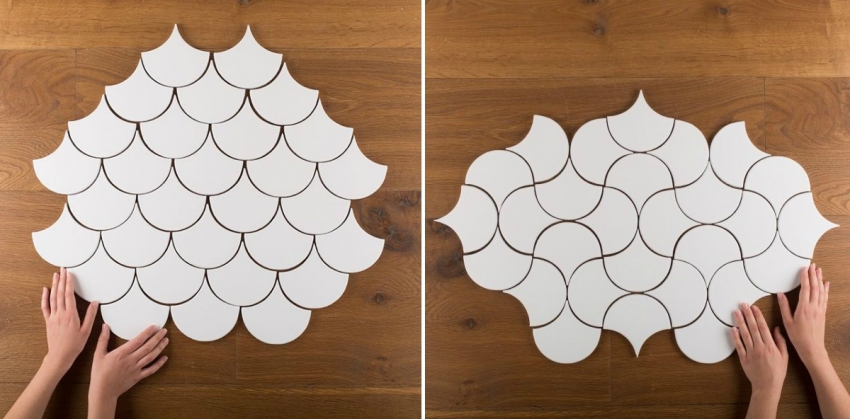
Contemporary ceramic tile collections include pieces that can be combined in different ways to create a unique pattern
At its core, this is a conventional ceramic tile, the outer side of which is divided into many parts, which gives it a mosaic-like appearance. Sometimes, to achieve the desired effect, manufacturers use a convex pattern, however, tiles with slots look more believable and effective.
Important! The slots in the tiles are filled with the same grout, which is also used for seams between individual elements. This complicates the maintenance of the apron, as it becomes much more difficult to keep the surface clean.
Beautiful aprons for the kitchen from medium-sized tiles
Kitchen apron, lined and standard size tiles, are much less common than any of the options above. The thing is that such a tile almost always requires a rather complex trimming, which allows the elements to organically fit into the interior.
Choosing a standard-size tile color, you should pay attention to unobtrusive monochromatic options, possibly decorated with a simple pattern. If we talk about size, then 20x20, 20x30 and 25x33 cm are best suited, as well as everything around that.
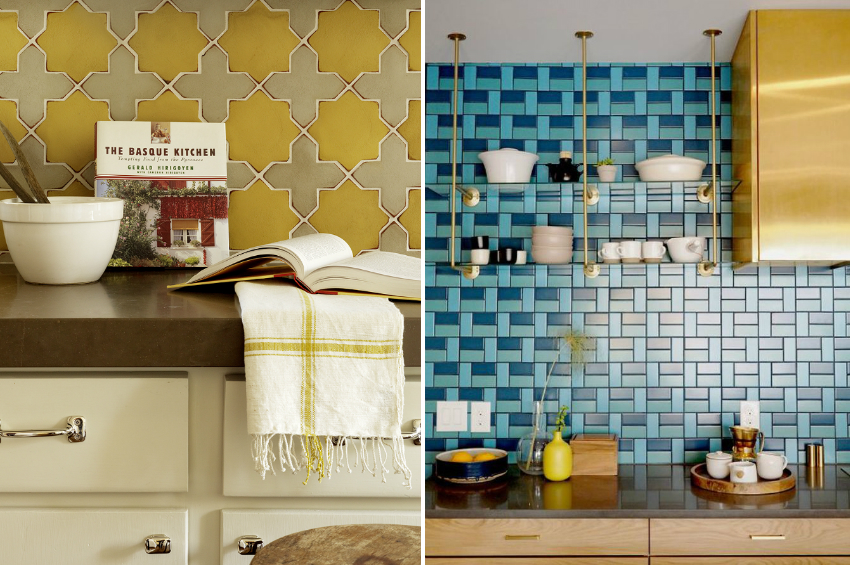
The color of the tiles for the apron must be chosen based on the general color scheme of the headset and wall decoration
If you need to arrange a small kitchen, then large tiles will look inappropriate.Despite the fact that the number of seams in such an apron will be less, the surface will be visually cluttered, which means that the whole kitchen will look even smaller.
How to diversify a plain tile apron in the kitchen: photo examples
Sometimes a plain tile apron can look somewhat boring and dull. To avoid this, you can use additional decorative elements. Of course, their cost is slightly higher than that of conventional plain elements, but fewer of them are required and they perfectly decorate the surface. Let's consider in more detail several options for how decorative inserts can be used, along with a photo of kitchen aprons.
Patterned tiles (flat or embossed) is the most common option. As a rule, they are the same size as the background elements and differ only in the presence of the pattern. Laying can be done pointwise, so that the elements are located at an equal distance from each other, or grouped into a small panel.
It is not at all necessary to use decorative elements from the same collection as the background ones. They often resort to using tiles from other manufacturers. The main thing is that the size and shape of the elements fit perfectly. In this case, the apron will look uniform, and there will be no problems with alignment.

Decorative panels made of ceramic tiles are often used for decoration country style kitchens
Tile decorative panel Is also a fairly common way to decorate a surface. This solution looks especially good if the design of the kitchen is in Provence, country or classic style.
There are two options for placing a decorative panel on an apron. In the first case, one large insert is located in the middle of the apron, and in the second, several (usually 4 or 6) separate pictures are used, which are arranged symmetrically.
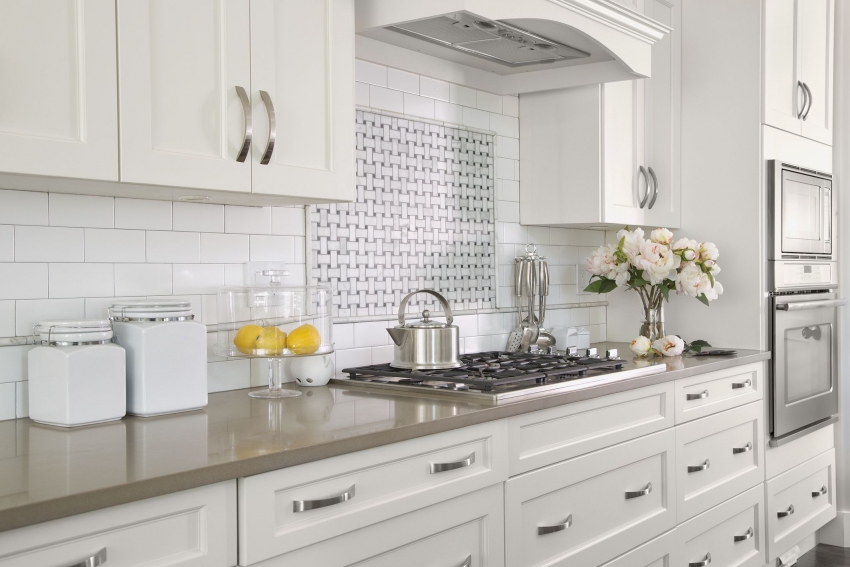
A decorative tile panel is most often placed above the stove, which takes the central place in the kitchen set.
The main rules for placing such a panel are a sufficient amount of space and symmetry. The picture will look best on the part of the wall where the hob is located, since it is usually the center of the backsplash. This can be seen by looking at the photo of the tiles on the kitchen apron in various interiors.
Traditional subjects for the panel are still lifes and simple landscapes, as well as city views (most often these are courtyards with tiled roofs), as well as everything related to cooking: olive oil, cheese, berries and fruits. Abstractions also look good, of course, provided that they are correctly selected and correspond to the theme of the room.
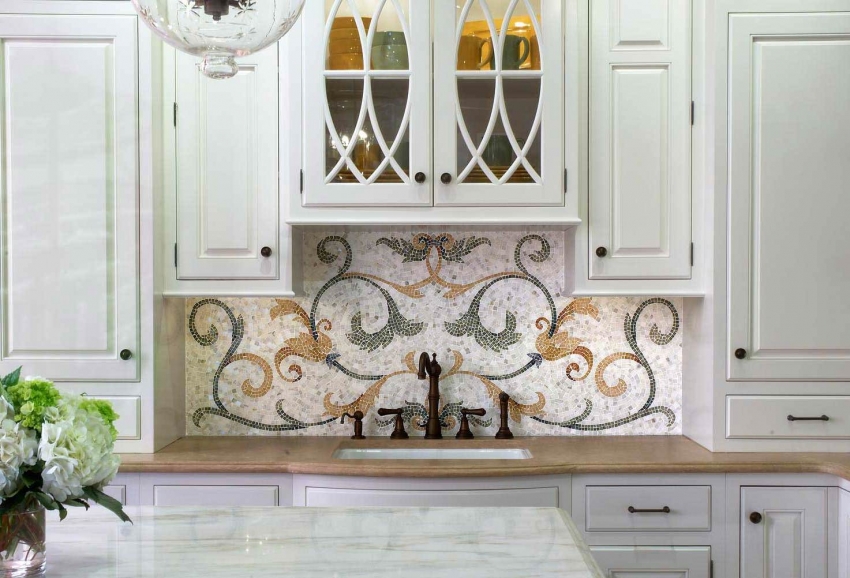
Handmade mosaic is an expensive and painstaking work that can bring extravagance and exclusivity to the interior of a classic kitchen
Tile-border Is a classic element of country-style kitchen design. In this case, the upper and lower edges of the apron are laid out with oblong tiles, thus outlining its borders. The strip of the same oblong tiles, launched in the middle, also looks great.
Decor pencil - these are long and narrow inserts that perfectly fill any gaps and avoid unnecessary trimming of the tile. In this case, you just need to choose the option that matches the color.
Tile kitchen apron: design photo in various styles
Looking through photos of aprons for a kitchen made of tiles, it is worth paying attention not only to their appearance, but also to how harmoniously they fit into the environment. After all, just picking up beautiful material is not enough. It should also correspond to the general style of interior decoration.
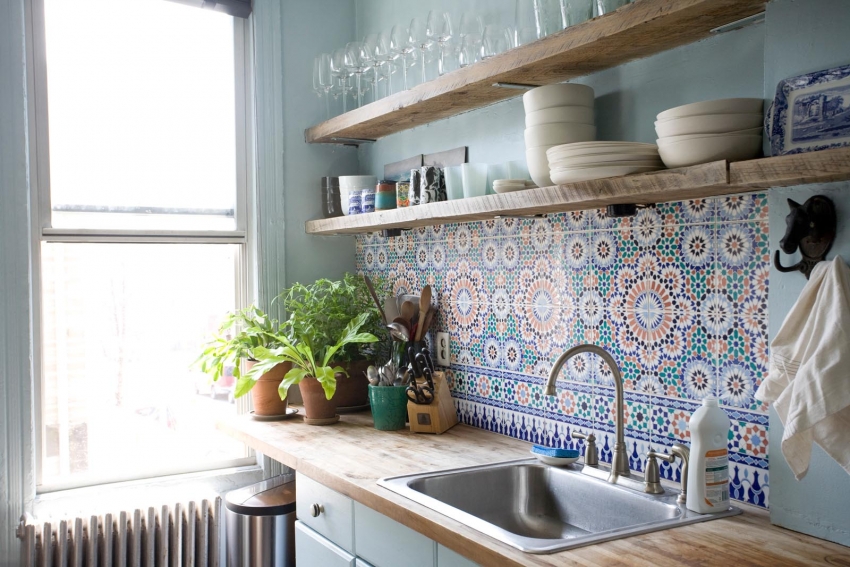
At registration apron kitchen with open shelves, tiles with an interesting ornament or shape should be used
Unobtrusive monochromatic tiles are best suited for decorating a kitchen in a modern style. Photo tiles or mosaic tiles will also look great. An imitation of a 10x10 tile will successfully complement the interior, and you can use both a monochromatic material and a tile with a pattern. If the space permits, you can give preference to medium-sized tiles with a bright pattern.
A completely different approach is required if you need to adhere to the classic kitchen design. Imitation of stone will be appropriate here, as well as smooth ceramics with classic decor. An antique ornament is a great idea. In addition, you can always use a small plain tile, since it is versatile and will fit perfectly into any interior.
Useful advice!In a classic interior, even black tiles can be used for a kitchen apron, however, this technique is permissible only in spacious rooms. In a small kitchen, it is better not to use such dark elements.

For classic white kitchen you can use tiles with interesting ornaments, which will make the interior more modern
Decorating in country style or Provence is a separate topic, the discussion of which can be devoted to a huge amount of time. However, if you highlight the main materials that are suitable for this purpose, then it is worth noting the following options:
- imitation of natural stone;
- imitation of old clay tiles;
- antique painting;
- mosaic with embossed ornament.
A great idea is to use a mosaic, the size of the elements of which is 5x5 cm. Such segments will not be too small, but at the same time they will give the interior a mood. You can verify this by looking at the photo of aprons for the kitchen made of ceramic tiles.
The best manufacturers of tiles for the kitchen on the apron: catalog and description
The first thing that should be noted, speaking about the production of tiles, is that domestic and Belarusian products occupy a worthy position on the market. Despite the fact that the cost of products is much lower in comparison with European counterparts, some manufacturers are able to compete in terms of quality and durability. Moreover, every year new collections appear, and equipment and production technologies are constantly being improved.
Among domestic and Belarusian products, most of the material is presented in neutral colors and shades, as well as with a traditional pattern. And although such tiles cannot yet compete with the Italian ones in terms of the complexity of the design, nevertheless, as a budget option, it is quite suitable for kitchen renovation.
Among the most popular brands, it is worth noting Kerama Marazzi, Uralkeramika, Karabel, Kerabud, Azori, Cersanit and many others.
Useful advice!FROMAmong all the listed companies, perhaps the most popular is Kerama Marazzi. Kitchen tile for an apron is not the only thing that is worth the attention of buyers and when planning a renovation, you should familiarize yourself with the range of this manufacturer in more detail.
Another popular and at the same time affordable tile today is made in China. There is no need to talk about any traditions in this area, since in most cases the Chinese copy the design of popular Italian or Spanish collections. Thus, for little money, you can get an inexpensive material that looks like an expensive designer tile. The main thing is to carefully approach the choice and make sure that the quality of the purchased tiles is acceptable.
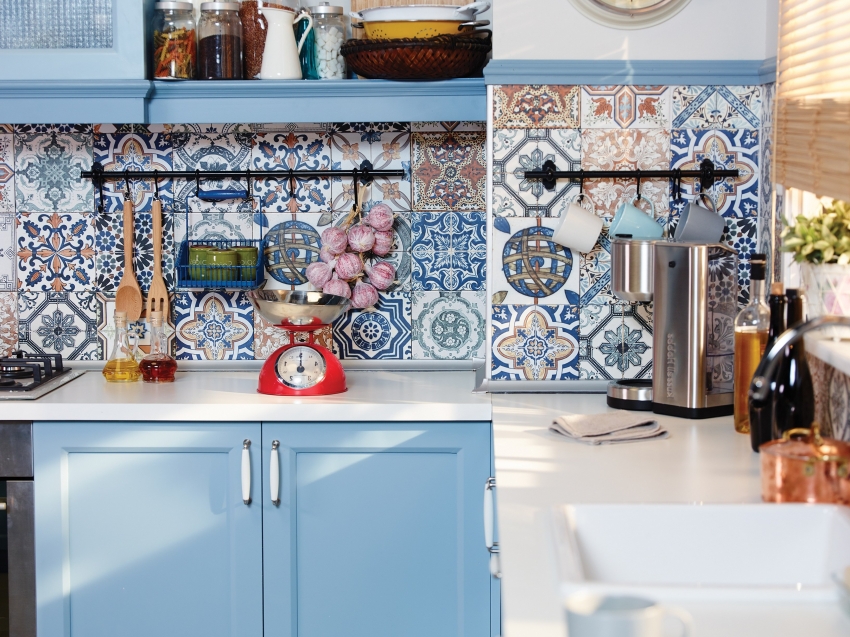
The collections of ceramic tiles made in Spain are among the most innovative and dynamic on the international market.
If you are an adherent of real quality, then it is better to pay attention to products made in a country like Spain. The kitchen tile for the apron is presented here in a variety of calm and fashionable shades. Spanish imitations, such as wood or stone tiles, are especially appreciated. In addition, in Spanish collections you can find a large selection of decorative elements that will become a worthy decoration and bring the desired flavor to your kitchen.
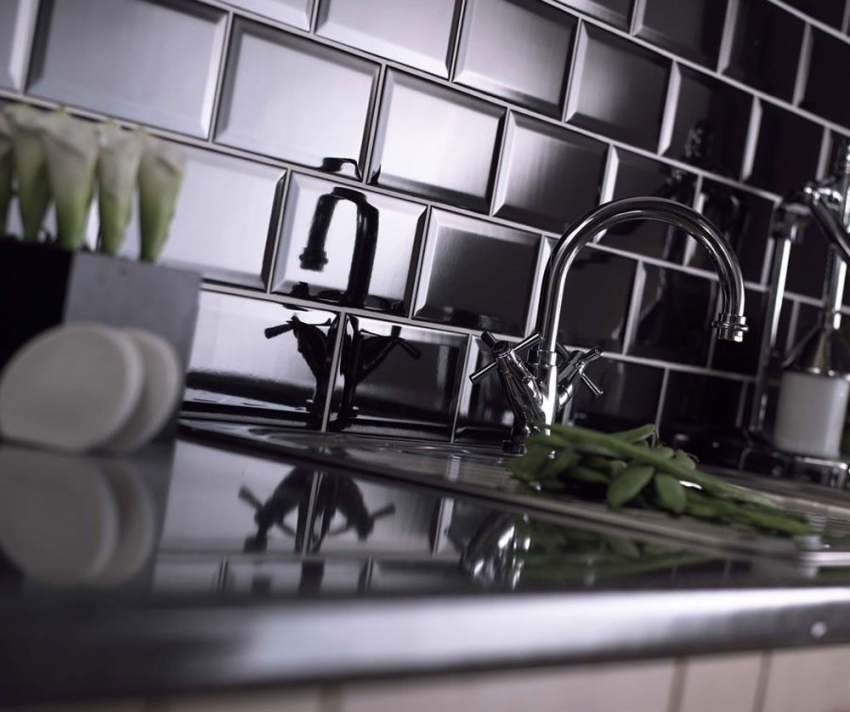
Modern manufacturers of ceramic tiles offer customers online catalogs with which you can see examples of the use of products in the interior.
Of course, one cannot fail to note the Italian ceramic tile for the kitchen apron, which has been considered the best for many years. The variety of original colors and textures is incredibly great. True, you will have to pay a lot for such a luxury, since Italian tiles are deservedly called the most expensive.
Helpful advice! Since the backsplash is usually not too large, you can look for leftover Italian tiles on sales. This will allow you to get the desired quality and beauty for quite reasonable money.
Looking through photo catalogs of apron tiles in the kitchen, you can be sure that the assortment is extremely large, and it is quite possible to choose an option for any budget. The main thing is to decide on the size of the apron for the kitchen, as well as the stylistic direction in which you want to decorate the surface.
